Rational Design and Multicomponent Synthesis of Lipid–Peptoid Nanocomposites towards a Customized Drug Delivery System Assembly
Abstract
:1. Introduction
2. Results and Discussion
3. Materials and Methods
3.1. Molecular Dynamics Simulation Details
3.2. Synthetic Procedures
3.2.1. General Procedure for the Ugi Reactions

- N-Octyl-N-(2-(octylamino)-2-oxoethyl)decanamide (5a) was obtained from capric acid (0.50 mmol, 0.086 g), paraformaldehyde (0.50 mmol, 0.015 g), n-octyl amine (0.50 mmol, 0.081 g), and n-octyl isocyanide (0.50 mmol, 0.089 mL), following the general procedure for Ugi reactions, in 74% yield (0.166 g) as a white solid after silica gel column chromatography (100% hexano → 20% ethyl acetate/hexane). Rf = 0.25 (20% ethyl acetate/hexane); m.p. 59–60 °C. 1H NMR (600 MHz, CDCl3) δ 6.76 (s, 1H), 3.97 (s, 2H), 3.41–3.32 (m, 2H), 3.24–3.13 (m, 2H), 2.45–2.30 (m, 2H), 1.75–1.65 (m, 2H), 1.62–1.53 (m, 2H), 1.50–1.44 (m, 2H), 1.29 (s, 32H), 0.90 (t, J = 7.0, 9H). 13C NMR (151 MHz, CDCl3) δ 174.4, 169.9, 51.5, 50.0, 39.4, 32.9, 31.9, 31.8, 31.7, 29.5, 29.5, 29.4, 29.3, 29.25, 29.23, 29.21, 28.8, 26.9, 26.7, 25.4, 22.7, 22.65, 22.61, 14.10, 14.08, 14.07. HRMS (ESI-TOF) m/z calculated for C28H56N2O2 + H+: 453.4420 [M + H]+; found 453.4412.
- N-Octyl-N-(2-(octylamino)-2-oxoethyl)palmitamide (5b) was obtained from palmitic acid (0.50 mmol, 0.128 mg), paraformaldehyde (0.50 mmol, 0.015 g), n-octyl amine (0.50 mmol, 0.081 g), and n-octyl isocyanide (0.50 mmol, 0.089 mL), following the general procedure for Ugi reactions, in 84% yield (0.223 g) as a white solid after silica gel column chromatography (100% hexane → 30% ethyl acetate/hexane). Rf = 0.37 (20% ethyl acetate/hexane); m.p. 57–59 °C. 1H NMR (600 MHz, CDCl3) δ 4.02–3.93 (m, 2H), 3.40–3.33 (m, 2H), 3.23–3.16 (m, 2H), 2.41–2.33 (m, 2H), 1.69–1.56 (m, 4H), 1.52–1.45 (m, 2H), 1.37–1.23 (m, 46H), 0.90 (t, J = 7.0, 9H). 13C NMR (151 MHz, CDCl3) δ 173.9, 171.5, 51.9, 51.4, 50.0, 48.6, 39.5, 33.4, 32.9, 31.9, 31.8, 31.7, 29.70, 29.68, 29.66, 29.55, 29.46, 29.36, 29.25, 29.24, 29.21, 28.7, 27.5, 26.9, 26.7, 25.4, 25.1, 22.69, 22.65, 22.61, 14.12, 14.08, 14.07, 11.9. HRMS (ESI-TOF) m/z calculated for C34H68N2O2 + H+: 537.5359 [M + H]+; found 537.5354.
- N-Octyl-N-(2-(octylamino)-2-oxoethyl)stearamide (5c) was obtained from stearic acid (0.50 mmol, 0.142 g), paraformaldehyde (0.50 mmol, 0.015 g), n-octyl amine (0.50 mmol, 0.081 g), and n-octyl isocyanide (0.50 mmol, 0.089 mL), following the general procedure for Ugi reactions, in 76% yield (0.214 g) as a white solid after silica gel column chromatography (100% hexane → 30% ethyl acetate/hexane). Rf = 0.35 (20% ethyl acetate/hexane); m.p. 54–56 °C. 1H NMR (600 MHz, CDCl3) δ 4.03–3.95 (m, 2H), 3.40–3.32 (m, 2H), 3.28–3.18 (m, 2H), 2.40–2.33 (m, 2H), 1.70–1.56 (m, 4H), 1.35–1.23 (m, 48H), 0.93–0.86 (m, 9H). 13C NMR (151 MHz, CDCl3) δ 174.5, 169.8, 51.4, 50.1, 39.6, 32.9, 31.9, 31.8, 31.7, 29.71, 29.68, 29.66, 29.55, 29.46, 29.41, 29.37, 29.24, 29.21, 28.8, 26.9, 26.7, 25.4, 22.69, 22.65, 22.62, 14.12, 14.08. HRMS (ESI-TOF) m/z calculated for C36H72N2O2 + H+: 565.5672 [M + H]+; found: 565.5668.
- N-(2-(tert-Butylamino)-2-oxoethyl)-N-methyldecanamide (8a) was obtained from capric acid (0.50 mmol, 0.086 g), paraformaldehyde (0.50 mmol, 0.015 g), methyl amine 2M in THF (0.50 mmol, 0.250 mL), and t-butyl isocyanide (0.50 mmol, 0.056 mL), following the general procedure for Ugi reactions, in 55% yield (0.082 g) as a colorless oil after silica gel column chromatography (20% ethyl acetate/hexane → 50% ethyl acetate/hexane). Rf = 0.60 (50% ethyl acetate). 1H NMR (600 MHz, CDCl3) δ 6.28 (s, 1H), 3.94–3.88 (m, 2H), 3.11 (s, 3H), 2.42–2.32 (m, 2H), 1.68–1.60 (m, 2H), 1.34–1.23 (m, 21H), 0.88 (t, J = 7.0 Hz, 3H). 13C NMR (151 MHz, CDCl3) δ 174.4, 168.5, 54.5, 53.4, 51.3, 36.9, 33.2, 31.8, 29.5, 29.42, 29.38, 29.26, 28.75, 28.68, 25.1, 22.6, 14.1. HRMS (ESI-TOF) m/z calculated for C17H34N2O2 + H+: 299.2699 [M + H]+; found: 299.2691.
- N-(tert-Butyl)-2-(N-dodecylacetamido)acetamide (8b) was obtained from acetic acid (0.50 mmol, 0.030 mL), paraformaldehyde (0.50 mmol, 0.015 g), n-dodecyl amine (0.50 mmol, 0.092 g), and t-butyl isocyanide (0.50 mmol, 0.056 mL), following the general procedure for Ugi reactions, in 88% yield (0.150 g) as a colorless oil after silica gel column chromatography (20% ethyl acetate/hexane → 50% ethyl acetate/hexane). Rf = 0.35 (30% ethyl acetate/hexane). 1H NMR (600 MHz, CDCl3) δ 6.54 (s, 1H), 3.90–3.85 (m, 2H), 3.40–3.28 (m, 2H), 2.16 (s, 3H), 1.64–1.57 (m, 2H), 1.32 (s, 9H), 1.28–1.20 (m, 18H), 0.89 (t, J = 7.0, 3H). 13C NMR (151 MHz, CDCl3) δ 171.4, 168.9, 52.2, 51.1, 50.8, 31.9, 29.55, 29.54, 29.48, 29.3, 29.2, 28.7, 28.62, 28.60, 26.7, 22.6, 21.1, 14.0.
- N-(tert-Butyl)-N-(2-(dodecylamino)-2-oxoethyl)acetamide (8c) was obtained from acetic acid (0.50 mmol, 0.030 g), paraformaldehyde (0.50 mmol, 0.015 g), t-butyl amine (0.50 mmol, 0.052 g), and n-dodecyl isocyanide (0.50 mmol, 0.098 g), following the general procedure for Ugi reactions, in 69% yield (0.079 g) as a white solid after silica gel column chromatography (20% ethyl acetate/hexane → 60% ethyl acetate/hexane). Rf = 0.45 (60% ethyl acetate/hexane). m.p. 81–83 °C. 1H NMR (600 MHz, CDCl3) δ 6.14 (s, 1H), 3.96 (s, 2H), 3.30 (q, J = 7.0 Hz, 2H), 2.09 (s, 3H), 1.57–1.50 (m, 2H), 1.45 (s, 9H), 1.32–1.22 (m, 18H), 0.86 (t, J = 7.0 Hz, 3H). 13C NMR (151 MHz, CDCl3) δ 172.5, 169.6, 57.9, 50.3, 39.5, 31.9, 29.61, 29.56, 29.54, 29.50, 29.3, 29.2, 28.8, 26.9, 25.3, 22.7, 14.1.
- N-(2-(tert-Butylamino)-2-oxoethyl)-N-methylstearamide (8d) was obtained from stearic acid (0.50 mmol, 0.142 g), paraformaldehyde (0.50 mmol, 0.015 g), methyl amine 2M in THF (0.50 mmol, 0.250 mL), and t-butyl isocyanide (0.50 mmol, 0.056 mL), following the general procedure for Ugi reactions, in 51% yield (0.103 g) as a white solid after silica gel column chromatography (100% hexane → 40% ethyl acetate/hexane). Rf = 0.20 (30% ethyl acetate/hexane). m.p. 73–74 °C. 1H NMR (600 MHz, CDCl3) δ 6.20 (s, 1H), 3.91 (s, 2H), 3.11 (s, 3H), 2.42–2.35 (m, 2H), 1.68–1.59 (m, 2H), 1.33 (s, 9H), 1.30–1.23 (m, 28H), 0.89 (t, J = 7.0 Hz, 3H). 13C NMR (151 MHz, CDCl3) δ 174.2, 168.5, 53.5, 36.9, 33.2, 31.9, 29.69, 29.67, 29.65, 29.62, 29.5, 29.43, 29.40, 29.36, 28.7, 25.1, 22.7, 14.1. HRMS (ESI-TOF) m/z calculated for C25H50N2O2 + H+: 411.3951 [M + H]+; found 411.3940.
- N-(tert-Butyl)-2-(N-octadecylacetamido)acetamide (8e) was obtained from acetic acid (0.50 mmol, 0.030 mL), paraformaldehyde (0.50 mmol, 0.015 g), octadecyl amine (0.50 mmol, 0.134 g), and t-butyl isocyanide (0.50 mmol, 0.056 mL), following the general procedure for Ugi reactions, in 87% yield (0.185 g) as a white solid after silica gel column chromatography (30% ethyl acetate/hexane → 50% ethyl acetate/hexane). Rf = 0.40 (50% ethyl acetate). m.p. 66–68 °C. 1H NMR (600 MHz, CDCl3) δ 6.53 (s, 1H), 3.93–3.86 (m, 2H), 3.41–3.28 (t, 2H), 2.15 (s, 3H), 1.62–1.52 (q, 2H), 1.32 (s, 9H), 1.29–1.0 (m, 30H), 0.88 (t, J = 6.9 Hz, 3H). 13C NMR (151 MHz, CDCl3) δ 171.8, 169.0, 52.1, 51.3, 51.0, 31.9, 29.70, 29.68, 29.66, 29.64, 29.61, 29.5, 29.4, 29.30, 28.6, 26.8, 22.7, 21.2, 14.1.
- N-(tert-Butyl)-N-(2-(octadecylamino)-2-oxoethyl)acetamide (8f) was obtained from acetic acid (0.50 mmol, 0.030 mL), paraformaldehyde (0.50 mmol, 0.015 g), t-butyl amine (0.50 mmol, 0.052 g), and octadecyl isocyanide (0.50 mmol, 0.084 g), following the general procedure for Ugi reactions, in 63% yield (0.080 g) as a white solid after silica gel column chromatography (30% ethyl acetate/hexane → 60% ethyl acetate/hexane). Rf = 0.20 (50% ethyl acetate/hexane). m.p. 84–85 °C. 1H NMR (600 MHz, CDCl3) δ 6.11 (s, 1H), 3.96 (s, 2H), 3.30 (q, J = 7.0 Hz, 2H), 2.09 (s, 3H), 1.57–1.46 (m, 2H), 1.45 (s, 9H), 1.32–1.22 (m, 30H), 0.88 (t, J = 7.0 Hz, 3H). 13C NMR (151 MHz, CDCl3) δ 172.5, 169.6, 57.9, 50.3, 39.5, 31.9, 29.71, 29.69, 29.67, 29.63, 29.59, 29.56, 29.52, 29.3, 29.2, 28.8, 26.9, 25.3, 22.7, 14.1. HRMS (ESI-TOF) m/z calculated for C26H52N2O2 + Na+: 447.3926 [M + H]+; found 447.3905.
- N-(2-(tert-Butylamino)-2-oxoethyl)-N-octylstearamide (8g) was obtained from stearic acid (0.50 mmol, 0.142 g), paraformaldehyde (0.50 mmol, 0.015 g), n-octyl amine (0.50 mmol, 0.082 g), and t-butyl isocyanide (0.50 mmol, 0.056 mL), following the general procedure for Ugi reactions, in 90% yield (0.228 g) as a white solid after silica gel column chromatography (100% hexane → 20% ethyl acetate/hexane). Rf = 0.42 (20% ethyl acetate/hexane). m.p. 56–58 °C. 1H NMR (600 MHz, CDCl3) δ 6.60 (s, 1H), 3.94–3.84 (m, 2H), 3.42–3.31 (m, 2H), 2.41–2.33 (m, 2H), 1.73–1.53 (m, 4H), 1.33 (s, 9H), 1.30–1.20 (m, 28H), 0.89 (t, J = 7.0 Hz, 6H). 13C NMR (151 MHz, CDCl3) δ 174.3, 169.3, 52.5, 51.1, 50.1, 32.9, 31.9, 31.8, 29.71, 29.68, 29.67, 29.64, 29.54, 29.45, 29.43, 29.37, 29.26, 29.21, 28.8, 28.6, 26.8, 25.5, 22.7, 22.6, 14.12, 14.07. HRMS (ESI-TOF) m/z calculated for C32H64N2O2 + H+: 509.5046 [M + H]+; found 509.5043.
- N-(2-(tert-Butylamino)-2-oxoethyl)-N-dodecylstearamide (8h) was obtained from stearic acid (0.50 mmol, 0.142 g), paraformaldehyde (0.50 mmol, 0.015 g), n-dodecyl amine (0.50 mmol, 0.092 g), and t-butyl isocyanide (0.50 mmol, 0.056 mL), following the general procedure for Ugi reactions, in 89% yield (0.151 g) as a white solid after silica gel column chromatography (100% hexane → 20% ethyl acetate/hexane). Rf = 0.40 (20% ethyl acetate/hexane). m.p. 55–57 °C. 1H NMR (600 MHz, CDCl3) δ 6.55 (s, 1H), 3.87 (s, 2H), 3.32–2.26 (m, 2H), 2.40–2.30 (m, 2H), 1.69–1.54 (m, 4H), 1.36–1.22 (m, 55H), 0.88 (t, J = 7.0 Hz, 6H). 13C NMR (151 MHz, CDCl3) δ 174.2, 169.2, 52.5, 51.0, 50.0, 32.9, 31.93, 31.9, 29.71, 29.69, 29.67, 29.64, 29.63, 29.61, 29.56, 29.55, 29.45, 29.43, 29.37, 29.34, 29.30, 28.8, 28.7, 28.6, 26.8, 25.5, 22.7, 14.1. HRMS (ESI-TOF) m/z calculated for C36H72N2O2 + H+: 565.5672 [M + H]+; found 565.5658.
- N-(2-(tert-Butylamino)-2-oxoethyl)-N-octadecylstearamide (8i) was obtained from stearic acid (0.50 mmol, 0.142 g), paraformaldehyde (0.50 mmol, 0.015 g), octadecyl amine (0.50 mmol, 0.134 g), and t-butyl isocyanide (0.50 mmol, 0.056 mL), following the general procedure for Ugi reactions, in 95% yield (0.308 g) as a white solid after silica gel column chromatography (100% hexane → 20% ethyl acetate/hexane). Rf = 0.53 (20% ethyl acetate/hexane). m.p. 90–92 °C. 1H NMR (600 MHz, CDCl3) δ 4.01–3.87 (m, 2H), 3.42–3.32 (m, 2H), 2.41–2.31 (m, 2H), 1.70–1.57 (m, 4H), 1.33 (s, 9H), 1.32–1.22 (m, 58H), 0.90 (t, J = 7.0 Hz, 6H). 13C NMR (151 MHz, CDCl3) δ 174.3, 169.1, 52.3, 51.6, 50.2, 32.8, 31.9, 29.71, 29.69, 29.67, 29.64, 29.57, 29.56, 29.54, 29.45, 29.42, 29.37, 29.30, 28.8, 28.6, 26.8, 25.5, 22.7, 14.1. HRMS (ESI-TOF) m/z calculated for C42H84N2O2 + H+: 649.6611 [M + H]+; found 649.6592.
- N-(tert-Butyl)-N-(2-(octylamino)-2-oxoethyl)stearamide (8j) was obtained from stearic acid (0.50 mmol, 0.142 g), paraformaldehyde (0.50 mmol, 0.015 g), t-buyl amine (0.50 mmol, 0.052 mL), and n-octyl isocyanide (0.50 mmol, 0.089 mL), following the general procedure for Ugi reactions, in 55% yield (0.138 g) as a white solid after silica gel column chromatography (100% hexane → 20% ethyl acetate/hexane). Rf = 0.33 (20% ethyl acetate/hexane). m.p. 50–52 °C. 1H NMR (600 MHz, CDCl3) δ 6.13 (s, 1H), 3.96 (s, 2H), 3.32 (q, J = 7.0 Hz, 2H), 2.23 (t, J = 7.0 Hz, 2H), 1.67–1.56 (m, 2H), 1.53–1.49 (m, 2H), 1.46 (s, 9H), 1.33–1.23 (m, 38H), 0.89 (t, J = 7.0 Hz, 6H). 13C NMR (151 MHz, CDCl3) δ 175.0, 169.9, 57.9, 49.4, 39.5, 36.3, 31.9, 31.7, 29.71, 29.68, 29.66, 29.65, 29.57, 29.54, 29.52, 29.4, 29.2, 28.8, 26.9, 25.4, 22.7, 22.6, 14.12, 14.07. HRMS (ESI-TOF) m/z calculated for C32H64N2O2 + H+: 509.5046 [M + H]+; found 509.5026.
- N-(tert-Butyl)-N-(2-(dodecylamino)-2-oxoethyl)stearamide (8k) was obtained from stearic acid (0.50 mmol, 0.142 g), paraformaldehyde (0.50 mmol, 0.015 g), t-buyl amine (0.50 mmol, 0.052 mL), and n-dodecyl isocyanide (0.50 mmol, 0.058 g), following the general procedure for Ugi reactions, in 73% yield (0.127 g) as a white solid after silica gel column chromatography (100% hexane → 20% ethyl acetate/hexane). Rf = 0.32 (20% ethyl acetate/hexane). m.p. 60–62 °C. 1H NMR (600 MHz, CDCl3) δ 6.11 (s, 1H), 3.96 (s, 2H), 3.32 (q, J = 7.0 Hz, 2H), 2.23 (t, J = 7.0 Hz, 2H), 1.68–1.57 (m, 2H), 1.55–1.48 (m, 2H), 1.46 (s, 9H), 1.34–1.24 (m, 46H), 0.90 (t, J = 7.0 Hz, 6H). 13C NMR (151 MHz, CDCl3) δ 174.9, 169.9, 57.8, 49.3, 39.5, 36.3, 31.92, 31.9, 29.69, 29.68, 29.67, 29.65, 29.64, 29.63, 29.61, 29.57, 29.56, 29.53, 29.50, 29.36, 29.35, 29.33, 29.24, 28.8, 26.9, 25.4, 22.7, 14.1. HRMS (ESI-TOF) m/z calculated for C36H72N2O2 + Na+: 587.5491 [M + Na]+; found 587.5472.
- N-(tert-Butyl)-N-(2-(octadecylamino)-2-oxoethyl)stearamide (8l) was obtained from stearic acid (0.50 mmol, 0.142 g), paraformaldehyde (0.50 mmol, 0.015 g), t-buyl amine (0.50 mmol, 0.052 mL), and octadecyl isocyanide (0.50 mmol, 0.084 g), following the general procedure for Ugi reactions, in 75% yield (0.146 g) as a white solid after silica gel column chromatography (100% hexane → 20% ethyl acetate/hexane). Rf = 0.62 (20% ethyl acetate/hexane). m.p. 85–87 °C. 1H NMR (600 MHz, CDCl3) δ 6.11 (s, 1H), 3.97 (s, 2H), 3.32 (q, J = 7.0 Hz, 2H), 2.23 (t, J = 7.0 Hz, 2H), 1.66–1.59 (m, 2H), 1.55–1.48 (m, 2H), 1.47 (s, 9H), 1.37–1.24 (m, 58H), 0.90 (t, J = 7.0 Hz, 6H). 13C NMR (151 MHz, CDCl3) δ 174.9, 169.9, 57.8, 49.4, 39.5, 36.3, 31.9, 29.68, 29.63, 29.59, 29.55, 29.52, 29.49, 29.37, 29.33, 29.23, 28.9, 26.9, 25.4, 22.6, 14.0. HRMS (ESI-TOF) m/z calculated for C42H84N2O2 + Na+: 671.6430 [M + Na]+; found 671.6422.
- N-Octyl-2-(N-octylacetamido)acetamide (8m) was obtained from acetic acid (0.50 mmol, 0.030 mL), paraformaldehyde (0.50 mmol, 0.015 g), n-octyl amine (0.50 mmol, 0.082 mL), and n-octyl isocyanide (0.50 mmol, 0.089 mL), following the general procedure for Ugi reactions, in 64% yield (0.108 g) as a white solid after silica gel column chromatography (40% ethyl acetate/hexane → 70% ethyl acetate/hexane). Rf = 0.35 (50% ethyl acetate/hexane). m.p. 60–62 °C. 1H NMR (600 MHz, CDCl3) δ 6.70 (s, 1H), 4.02–3.91 (m, 2H), 3.40–3.31 (m, 2H), 3.24–3.14 (m, 2H), 2.16 (s, 3H), 1.66–1.57 (m, 2H), 1.51–1.42 (m, 2H), 1.33–1.21 (m, 20H), 0.89 (t, J = 7.0 6H). 13C NMR (151 MHz, CDCl3) δ 171.7, 169.6, 51.2, 50.8, 39.5, 31.8, 31.7, 29.4, 29.25, 29.21, 29.20, 28.6, 26.9, 26.7, 22.64, 22.60, 21.2, 14.08, 14.06. HRMS (ESI-TOF) m/z calculated for C20H40N2O2 + Na+: 363.2987 [M + Na]+; found 363.2979.
- N-Dodecyl-2-(N-dodecylacetamido)acetamide (8n) was obtained from acetic acid (0.50 mmol, 0.030 mL), paraformaldehyde (0.50 mmol, 0.015 g), n-dodecyl amine (0.50 mmol, 0.055 g), and n-dodecyl isocyanide (0.50 mmol, 0.058 mL), following the general procedure for Ugi reactions, in 52% yield (0.070 g) as a white solid after silica gel column chromatography (30% ethyl acetate/hexane → 60% ethyl acetate/hexane). Rf = 0.28 (60% ethyl acetate/hexane). m.p. 77–78 °C. 1H NMR (600 MHz, CDCl3) δ 6.72 (s, 1H), 3.96 (s, 2H), 3.38–3.32 (m, 2H), 3.23–3.14 (m, 2H), 2.16 (s, 3H), 1.62–1.54 (m, 2H), 1.49–1.41 (m, 2H), 1.29–1.23 (m, 37H), 0.88 (t, J = 7.0 Hz, 6H). 13C NMR (151 MHz, CDCl3) δ 171.7, 169.6, 51.2, 50.9, 39.5, 31.9, 29.66, 29.64, 29.61, 29.60, 29.56, 29.55, 29.42, 29.35, 29.33, 29.30, 29.27, 28.6, 26.9, 26.7, 22.7, 21.2, 14.1. HRMS (ESI-TOF) m/z calculated for C28H56N2O2 + H+: 453.4420 [M + H]+; found 453.4407.
- N-Octadecyl-2-(N-octadecylacetamido)acetamide (8o) was obtained from acetic acid (0.50 mmol, 0.030 mL), paraformaldehyde (0.50 mmol, 0.015 g), octadecyl amine (0.50 mmol, 0.134 g), and octadecyl isocyanide (0.50 mmol, 0.084 g), following the general procedure for Ugi reactions, in 64% yield (0.197 g) as a white solid, which was used without further purification. The product precipitated and was filtered under vacuum. m.p. 89–91 °C. 1H NMR (600 MHz, CDCl3) δ 6.61 (s, 1H), 3.95 (s, 2H), 3.42–3.32 (m, 2H), 3.24–3.17 (m, 2H), 2.17 (s, 3H), 1.67–1.57 (m, 2H), 1.49–1.42 (m, 2H), 1.32–1.23 (m, 60H), 0.90 (t, J = 7.0 Hz, 6H). 13C NMR (151 MHz, CDCl3) δ 171.5, 169.6, 51.3, 50.8, 39.4, 31.9, 29.70, 29.66, 29.62, 29.60, 29.56, 29.55, 29.52, 29.45, 29.36, 29.30, 29.27, 28.6, 26.9, 26.7, 22.7, 21.2, 14.1. HRMS (ESI-TOF) m/z calculated for C40H80N2O2 + H+: 621.6298 [M + H]+; found 621.6284.
- N-Dodecyl-N-(2-(octylamino)-2-oxoethyl)stearamide (8p) was obtained from stearic acid (0.50 mmol, 0.142 g), paraformaldehyde (0.50 mmol, 0.015 g), dodecyl amine (0.50 mmol, 0.082 mL), and n-octyl isocyanide (0.50 mmol, 0.089 mL), following the general procedure for Ugi reactions, in 59% yield (0.181 g) as a white solid after silica gel column chromatography (100% hexane → 30% ethyl acetate/hexane). Rf = 0.42 (20% ethyl acetate/hexane) m.p. 66–68 °C 1H NMR (600 MHz, CDCl3) δ 6.69 (s, 1H), 3.94 (s, 2H), 3.39–3.29 (m, 2H), 3.22–3.14 (m, 2H), 2.39–2.31 (m, 2H), 1.72–1.40 (m, 6H), 1.35–1.22 (m, 56H), 0.94–0.82 (m, 9H). 13C NMR (151 MHz, CDCl3) δ 174.3, 169.9, 51.5, 50.0, 39.4, 32.9, 31.94, 31.92, 31.8, 29.71, 29.69, 29.67, 29.63, 29.56, 29.48, 29.46, 29.37, 29.35, 29.30, 29.25, 28.7, 26.9, 26.7, 25.4, 22.69, 22.65, 14.12, 14.09. HRMS (ESI-TOF) m/z calculated for C40H80N2O2 + H+: 621.6298 [M + H]+; found 621.6291.
- N-(2-(Dodecylamino)-2-oxoethyl)-N-octylstearamide (8q) was obtained from stearic acid (0.50 mmol, 0.142 g), paraformaldehyde (0.50 mmol, 0.015 g), n-octyl amine (0.50 mmol, 0.082 mL), and dodecyl isocyanide (0.50 mmol, 0.098 g), following the general procedure for Ugi reactions, in 82% yield (0.254 g) as a white solid after silica gel column chromatography (100% hexane → 20% ethyl acetate/hexane). Rf = 0.24 (10% ethyl acetate/hexane) m.p. 64–66 °C. 1H NMR (600 MHz, CDCl3) δ 4.03–3.95 (m, 2H), 3.37–3.32 (m, 2H), 3.22–3.16 (m, 2H), 2.40–2.31 (m, 2H), 1.68–1.51 (m, 4H), 1.33–1.22 (m, 56H), 0.88 (t, J = 7.0, 9H). 13C NMR (151 MHz, CDCl3) δ 174.7, 170.0, 51.3, 50.1, 39.5, 32.9, 31.93, 31.7, 29.71, 29.69, 29.68, 29.67, 29.65, 29.63, 29.59, 29.55, 29.47, 29.37, 29.29, 29.25, 29.21, 28.7, 26.9, 26.7, 25.4, 22.7, 22.6, 14.12, 14.07. HRMS (ESI-TOF) m/z calculated for C40H80N2O2 + H+: 621.6298 [M + H]+; found 621.6283.
- N-Dodecyl-N-(2-(dodecylamino)-2-oxoethyl)stearamide (8r) was obtained from stearic acid (0.50 mmol, 0.142 g), paraformaldehyde (0.50 mmol, 0.015 g), dodecyl amine (0.50 mmol, 0.092 g), and dodecyl isocyanide (0.50 mmol, 0.098 g), following the general procedure for Ugi reactions, in 75% yield (0.253 g) as a white solid after silica gel column chromatography (100% hexane → 30% ethyl acetate/hexane). Rf = 0.51 (30% ethyl acetate/hexane). m.p. 66–68 °C. 1H NMR (600 MHz, CDCl3) δ 6.93 (s, 1H), 3.99 (s, 2H), 3.39–3.30 (m, 2H), 3.24–3.14 (m, 2H), 2.39–2.31 (m, 2H), 1.68–1.44 (m, 6H), 1.32–1.21 (m, 64H), 0.88 (t, J = 7.0 Hz, 9H). 13C NMR (151 MHz, CDCl3) δ 174.6, 170.0, 51.4, 50.1, 39.5, 32.9, 31.93, 31.92, 29.72, 29.69, 29.67, 29.64, 29.63, 29.59, 29.57, 29.47, 29.39, 29.37, 29.36, 29.30, 28.8, 26.9, 26.7, 25.4, 22.7, 14.1. HRMS (ESI-TOF) m/z calculated for C44H88N2O2 + H+: 677.6924 [M + H]+; found 677.6916.
- N-Octadecyl-N-(2-(octadecylamino)-2-oxoethyl)stearamide (8s) was obtained from stearic acid (0.50 mmol, 0.142 g), paraformaldehyde (0.50 mmol, 0.015 g), octadecyl amine (0.50 mmol, 0.134 g), and octadecyl isocyanide (0.50 mmol, 0.140 g), following the general procedure for Ugi reactions, in 87% yield (0.367 g) as a white solid, which was used without further purification. The product precipitated and was filtered under vacuum. m.p. 83–85 °C. 1H NMR (600 MHz, CDCl3) δ 6.69 (s, 1H), 3.96 (s, 1H), 3.51 (s, 1H), 3.41–3.32 (m, 2H), 3.28–3.16 (m, 2H), 2.41–2.30 (m, 2H), 1.70–1.55 (m, 4H), 1.51–1.41 (m, 2H), 1.40–1.19 (m, 88H), 0.90 (t, J = 7.0 Hz, 9H). 13C NMR (151 MHz, CDCl3) δ 174.3, 169.9, 51.5, 50.0, 39.4, 32.9, 31.9, 29.71, 29.69, 29.68, 29.66, 29.64, 29.61, 29.60, 29.57, 29.55, 29.46, 29.36, 29.30, 29.28, 29.1, 28.7, 26.9, 26.7, 25.4, 24.8, 22.7, 14.1.
- N-Octyl-N-(2-oxo-2-(phenylamino)ethyl)stearamide (8t) was obtained from stearic acid (0.50 mmol, 0.142 g), paraformaldehyde (0.50 mmol, 0.015 g), n-octyl amine (0.50 mmol, 0.082 mL), and pheyl isocyanide (0.50 mmol, 0.051 g), following the general procedure for Ugi reactions, in 85% yield (0.224 g) as a pale yellow oil after silica gel column chromatography (100% hexane → 20% ethyl acetate/hexane). Rf = 0.57 (20% ethyl acetate/hexane). 1H NMR (600 MHz, CDCl3) δ 8.98 (s, 1H), 7.51 (d, J = 7.0 Hz, 2H), 7.31 (t, J = 7.0 Hz, 2H), 7.10 (t, J = 7.0 Hz, 1H), 4.11 (s, 2H), 3.46–3.37 (m, 2H), 2.42–2.34 (m, 2H), 1.73–1.58 (m, 4H), 1.35–1.23 (m, 38H), 0.90 (t, J = 7.0, 6H). 13C NMR (151 MHz, CDCl3) δ 175.0, 168.1, 138.0, 128.9, 124.1, 119.8, 61.9, 53.0, 50.3, 32.9, 31.9, 31.7, 29.70, 29.68, 29.65, 29.62, 29.52, 29.44, 29.42, 29.35, 29.22, 29.16, 28.7, 26.7, 25.4, 22.7, 22.6, 14.1, 14.0. HRMS (ESI-TOF) m/z calculated for C34H60N2O2 + Na+: 551.4552 [M + Na]+; found 551.4545.
- Methyl N-octyl-N-stearoylglycylglycinate (8u) was obtained from stearic acid (0.50 mmol, 0.142 g), paraformaldehyde (0.50 mmol, 0.015 g), n-octyl amine (0.50 mmol, 0.082 mL), and methyl isocyanoacetate (0.50 mmol, 0.045 mL), following the general procedure for Ugi reactions, in 65% yield (0.171 g) as a white solid after silica gel column chromatography (20% ethyl acetate/hexane → 50% ethyl acetate/hexane). Rf = 0.40 (50% ethyl acetate/hexane). m.p. 54–56 °C. 1H NMR (600 MHz, CDCl3) δ 7.08 (s, 1H), 4.04–3.99 (m, 4H), 3.75 (s, 3H), 3.40–3.35 (m, 2H), 2.44–2.35 (m, 2H), 1.71–1.55 (m, 4H), 1.33–1.23 (m, 36H), 0.90 (t, J = 7.0, 6H). 13C NMR (151 MHz, CDCl3) δ 174.6, 170.02, 169.98, 52.2, 50.8, 49.9, 41.0, 32.9, 31.9, 31.7, 29.69, 29.67, 29.64, 29.63, 29.51, 29.43, 29.34, 29.22, 29.17, 28.7, 26.7, 25.3, 22.7, 22.6, 14.1, 14.0. HRMS (ESI-TOF) m/z calculated for C31H60N2O4 + Na+: 547.4451 [M + Na]+; found 547.4435.
- N-Octyl-N-stearoylglycylglycine (8v): A Biotage microwave reaction vial of 0.5–2.0 mL containing a solution of peptoid 8u (0.10 mmol, 0.052 g) in THF/H2O (1:1, 0.6 mL) and LiOH (0.50 mmol, 0.012 g) was introduced in the cavity of a microwave reactor (Biotage® Initiator+) and irradiated at 60 °C for 10 min under magnetic stirring. The reaction mixture was then acidified with a 2 M solution of NaHSO4 to pH 2 and extracted twice with ethyl acetate (3 × 10 mL). The organic phase was dried over sodium sulfate, filtered, and then concentrated to yield acid 8v (0.045 g) as a white solid in 88%, which was used without further purification. m.p. 72–74 °C 1H NMR (600 MHz, CDCl3) δ 7.12 (s, 1H), 4.12–3.97 (m, 4H), 3.40 (s, 2H), 2.45–2.35 (m, 2H), 1.69–1.57 (m, 4H), 1.36–1.25 (m, 38H), 0.90 (t, J = 7.0, 6H). 13C NMR (151 MHz, CDCl3) δ 175.2, 172.0, 169.7, 50.6, 50.0, 41.3, 32.9, 31.9, 31.7, 29.72, 29.70, 29.67, 29.55, 29.40, 29.37, 29.24, 29.20, 28.6, 26.7, 25.3, 22.7, 22.6, 14.12, 14.08.
- N-(1-(4-Hydroxyphenyl)-2-(octylamino)-2-oxoethyl)-N-octylstearamide (11a) was obtained from stearic acid (0.50 mmol, 0.142 g), p-OH-benzaldehyde (0.50 mmol, 0.061 g), n-octyl amine (0.50 mmol, 0.082 mL), and n-octyl isocyanide (0.50 mmol, 0.089 mL), following the general procedure for Ugi reactions, in 47% yield (0.153 g) as a pale yellow oil. It was necessary to carry out two purifications because of the remaining p-OH-benzaldehyde. After the silica gel column chromatography (100% hexane → 30% ethyl acetate/hexane), the isolated oil was dissolved in dichloromethane and extracted twice with 1 M NaOH (2 × 10 mL). The organic phase was dried over sodium sulfate, filtered, and then concentrated. Rf = 0.55 (20% ethyl acetate/hexane). 1H NMR (600 MHz, CDCl3) δ 7.20 (d, J = 8.0 Hz, 2H), 6.80 (d, J = 8.0 Hz, 2H), 5.71 (s, 1H), 3.35–3.19 (m, 4H), 2.44–2.33 (m, 2H), 1.73–1.62 (m, 2H), 1.50–1.35 (m, 4H), 1.36–1.12 (m, 48H), 0.91–0.86 (m, 9H). 13C NMR (151 MHz, CDCl3) δ 174.6, 170.6, 156.9, 130.6, 126.3, 115.8, 62.7, 47.4, 39.8, 33.6, 31.9, 31.8, 31.7, 29.73, 29.71, 29.69, 29.67, 29.58, 29.52, 29.47, 29.37, 29.33, 29.21, 29.13, 28.95, 26.90, 26.87, 25.5, 22.70, 22.64, 22.61, 14.12, 14.09, 14.08. HRMS (ESI-TOF) m/z calculated for C42H76N2O2 + Na+: 679.5754 [M + H]+; found 679.5725.
- N-Octyl-N-(1-(octylamino)-1-oxooctan-2-yl)stearamide (11b) was obtained from stearic acid (0.50 mmol, 0.142 g), n-heptaldehyde (0.50 mmol, 0.070 mL), n-octyl amine (0.50 mmol, 0.082 mL), and n-octyl isocyanide (0.50 mmol, 0.089 mL), following the general procedure for Ugi reactions, in 58% yield (0.086 g) as a pale yellow oil after silica gel column chromatography (100% hexane → 20% ethyl acetate/hexane). Rf = 0.50 (10% ethyl acetate/hexane). 1H NMR (600 MHz, CDCl3) δ 6.69 (s, 1H), 4.73 (s, 1H), 3.34–3.08 (m, 4H), 2.40–2.29 (m, 2H), 1.78–1.42 (m, 8H), 1.35–1.20 (m, 56H), 0.94–0.83 (m, 12H). 13C NMR (151 MHz, CDCl3) δ 174.8, 171.6, 58.0, 45.2, 39.2, 33.6, 31.9, 31.82, 31.76, 31.67, 30.1, 29.71, 29.69, 29.66, 29.56, 29.49, 29.37, 29.24, 29.14, 29.10, 28.1, 27.1, 26.9, 26.2, 25.6, 22.69, 22.65, 22.63, 22.56, 14.12, 14.08, 14.07, 14.04. HRMS (ESI-TOF) m/z calculated for C42H84N2O2 + H+: 649.6611 [M + H]+; found 649.6607.
- N-(1-(Octylamino)-1-oxooctan-2-yl)stearamide (11c) was obtained from stearic acid (0.50 mmol, 0.142 g), n-heptaldehyde (0.50 mmol, 0.070 mL), ammonia solution 7 M in methanol (0.50 mmol, 0.070 mL), and n-octyl isocyanide (0.50 mmol, 0.089 mL), following the general procedure for Ugi reactions, in 40% yield (0.107 g) as a colorless oil after silica gel column chromatography (100% hexane → 30% ethyl acetate/hexane). Rf = 0.44 (20% ethyl acetate/hexane). 1H NMR (600 MHz, CDCl3) δ 4.50 (s, 1H), 3.37–3.17 (m, 2H), 2.32–2.20 (m, 2H), 1.72–1.41 (m, 8H), 1.33–1.24 (m, 44H), 0.95–0.85 (m, 9H). 13C NMR (151 MHz, CDCl3) δ 177.4, 172.1, 53.3, 39.8, 36.6, 33.83, 32.4, 31.94, 31.8, 31.6, 29.7, 29.69, 29.67, 29.65, 29.62, 29.5, 29.4, 29.3, 29.29, 29.26, 29.24, 29.22, 29.1, 29.03, 26.9, 25.7, 25.6, 24.8, 22.7, 22.6, 22.5, 14.1, 14.09, 14.04. HRMS (ESI-TOF) m/z calculated for C34H68N2O2 + H+: 537.5359 [M + H]+; found 537.5352.
3.2.2. General Procedure for Nanoparticle Preparation
4. Conclusions
Supplementary Materials
Author Contributions
Funding
Institutional Review Board Statement
Informed Consent Statement
Data Availability Statement
Acknowledgments
Conflicts of Interest
Sample Availability
References
- Selvamuthukumar, S.; Velmurugan, R. Nanostructured Lipid Carriers: A Potential Drug Carrier for Cancer Chemotherapy. Lipids Health Dis. 2012, 11, 159. [Google Scholar] [CrossRef] [PubMed] [Green Version]
- Ewelina, M.; Agnieszka, F.-G.; Izabela, N. Synthesis and Potential Applications of Lipid Nanoparticles in Medicine. Materials 2022, 15, 682. [Google Scholar]
- Biswas, A.K.; Islam, M.R.; Choudhury, Z.S.; Mostafa, A.; Kadir, M.F. Nanotechnology Based Approaches in Cancer Therapeutics. Adv. Nat. Sci. Nanosci. Nanotechnol. 2014, 5, 043001. [Google Scholar] [CrossRef]
- Mitchell, M.J.; Billingsley, M.M.; Haley, R.M. Engineering Precision Nanoparticles for Drug Delivery. Nat. Rev. Drug Discov. 2021, 20, 101–124. [Google Scholar] [CrossRef] [PubMed]
- Patra, J.K.; Das, G.; Fraceto, L.F. Nano Based Drug Delivery Systems: Recent Developments and Future Prospects. J. Nanobiotechnol. 2018, 16, 71. [Google Scholar] [CrossRef] [PubMed] [Green Version]
- Sim, S.; Sim, S. Nanotechnology and Its Use in Imaging and Drug Delivery (Review). Biomed. Rep. 2021, 14, 42. [Google Scholar] [CrossRef]
- Lombardo, D.; Kiselev, M.A.; Caccamo, M.T. Smart Nanoparticles for Drug Delivery Application: Development of Versatile Nanocarrier Platforms in Biotechnology and Nanomedicine. J. Nanomater. 2019, 2019, 3702518. [Google Scholar] [CrossRef]
- Kakade, T.; Kadam, V.; Dhanavade, K.; Salunkhe, V. A Review on Pharmaceutical Nanotechnology: Dendrimers. World J. Pharm. Sci. 2013, 2, 4815–4830. [Google Scholar]
- Singh, O.P.; Nehru, R.M. Nanotechnology and Cancer Treatment. Asian J. Exp. Sci. 2008, 22, 45–50. [Google Scholar]
- Shubhik, K. Nanotechnology and Medicine—The Upside and the Downside. Int. J. Drug Dev. Res. 2013, 5, 1–10. [Google Scholar]
- Dunn, A.; Dunn, D.; Macmillan, A.; Whan, R.; Stait-Gardner, T.; Price, W.; Lim, M.; Boyer, C. Spatial and Temporal Control of Drug Release through pH and Alternating Magnetic Field Induced Breakage of Schiff Base Bonds. Polym. Chem. 2014, 5, 3311–3315. [Google Scholar] [CrossRef]
- Allen, T.M.; Cullis, P.R. Drug Delivery Systems: Entering the Mainstream. Science 2004, 303, 1818–1822. [Google Scholar] [CrossRef] [PubMed] [Green Version]
- Fattal, E.; Hillaireau, H.; Mura, S.; Nicolas, J.; Tsapis, N. Targeted Delivery Using Biodegradable Polymeric Nanoparticles. In Fundamentals and Applications of Controlled Release Drug Delivery; Siepmann, J., Siegel, R.A., Rathbone, M.J., Eds.; CRS & Springer: New York, NY, USA, 2012; pp. 255–288. [Google Scholar]
- Kudr, J.; Haddad, Y.; Richtera, L.; Heger, Z.; Cernak, M.; Adam, V.; Zitka, O. Magnetic Nanoparticles: From Design and Synthesis to Real World Applications. Nanomaterials 2017, 7, 243. [Google Scholar] [CrossRef]
- Sanii, B. Structure-Determining Step in the Hierarchical Assembly of Peptoid Nanosheets. ACS Nano 2014, 8, 11674–11684. [Google Scholar] [CrossRef] [PubMed]
- Rezai, T.; Bock, J.E.; Zhou, M.V.; Kalyanaraman, C.; Lokey, R.S.; Jacobson, M.P. Conformational Flexibility, Internal Hydrogen Bonding, and Passive Membrane Permeability: Successful in Silico Prediction of the Relative Permeabilities of Cyclic Peptides. J. Am. Chem. Soc. 2006, 128, 14073–14080. [Google Scholar] [CrossRef] [PubMed]
- Ovadia, O.; Linde, Y.; Haskell-Luevano, C.; Dirain, M.L.; Sheynis, T.; Jelinek, R.; Gilon, C.; Hoffman, A. The Effect of Backbone Cyclization on PK/PD Properties of Bioactive Peptide-Peptoid Hybrids: The Melanocortin Agonist Paradigm. Bioorg. Med. Chem. 2010, 18, 580–589. [Google Scholar] [CrossRef] [PubMed]
- Sun, J.; Zuckermann, R.N. Peptoid Polymers: A Highly Designable Bioinspired Material. ACS Nano 2013, 7, 4715–4732. [Google Scholar] [CrossRef]
- Miller, S.M.; Simon, R.J.; Ng, S.; Zuckermann, R.N.; Kerr, J.M.; Moos, W.H. Comparison of the Proteolytic Susceptibilities of Homologous L-Amino-Acid, D-Amino-Acid, and N-Substituted Glycine Peptide and Peptoids Oligomers. Drug Dev. Res. 1995, 35, 20–32. [Google Scholar] [CrossRef]
- Knight, A.S.; Zhou, E.Y.; Francis, M.B.; Zuckermann, R.N. Sequence Programmable Peptoid Polymers for Diverse Materials Applications. Adv. Mater. 2015, 27, 5665–5691. [Google Scholar] [CrossRef]
- Clapperton, A.M.; Babi, J.; Tran, H. A Field Guide to Optimizing Peptoid Synthesis. ACS Polym. Au 2022, 2, 417–429. [Google Scholar] [CrossRef]
- Chen, C.L.; Qi, J.; Tao, J.; Zuckermann, R.N.; DeYoreo, J.J. Tuning Calcite Morphology and Growth Acceleration by a Rational Design of Highly Stable Protein-Mimetics. Sci. Rep. 2014, 4, 6266. [Google Scholar] [CrossRef] [Green Version]
- Murnen, H.K.; Rosales, A.M.; Jaworsk, J.N.; Segalman, R.A.; Zuckermann, R.N. Hierarchical Self-Assembly of a Biomimetic Diblock Copolypeptoid into Homochiral Superhelices. J. Am. Chem. Soc. 2010, 132, 16112–16119. [Google Scholar] [CrossRef]
- Mannige, R.V.; Haxton, T.K.; Proulx, C.; Robertson, E.J.; Battigelli, A.; Butterfoss, G.L.; Zuckermann, R.N.; Whitelam, S. Peptoid Nanosheets Exhibit a New Secondary-Structure Motif. Nature 2015, 526, 415–420. [Google Scholar] [CrossRef] [Green Version]
- Ma, J.; Cai, B.; Zhang, S.; De Yoreo, J.J.; Chen, C.; Baneyx, F. Nanoparticle-Mediated Assembly of Peptoid Nanosheets Functionalized with Solid-Binding Proteins: Designing Heterostructures for Hierarchy. Nano Lett. 2021, 21, 1636–1642. [Google Scholar] [CrossRef] [PubMed]
- Cardoso, R.V.; Pereira, P.R.; Freitas, C.S.; Paschoalin, V.M.F. Trends in Drug Delivery Systems for Natural Bioactive Molecules to Treat Health Disorders: The Importance of Nano-Liposomes. Pharmaceutics 2022, 14, 2808. [Google Scholar] [CrossRef]
- Dömling, A.; Ugi, I. Multicomponent Reactions with Isocyanides. Angew. Chem. Int. Ed. 2000, 39, 3168–3210. [Google Scholar] [CrossRef]
- Ugi, I.; Meyr, R.; Fetzer, U.; SteinBrückner, C. Versuche mit Isonitrilen. Angew. Chem. Int. Ed. Engl. 1959, 71, 386–388. [Google Scholar]
- Zhao, M. Hierarchical Assemblies of Polypeptoids for Rational Design of Advanced Functional Nanomaterials. Biopolymers 2021, 112, e23469. [Google Scholar] [CrossRef]
- Zarganes-Tzitzikas, T.; Chandgude, A.L.; Dömling, A. Multicomponent Reactions, Union of MCRs and Beyond. Chem. Rec. 2015, 15, 981–996. [Google Scholar] [CrossRef]
- Hügel, H.M. Microwave Multicomponent Synthesis. Molecules 2009, 14, 4936–4972. [Google Scholar] [CrossRef] [Green Version]
- Barreto, A.F.S.; Vercillo, O.E.; Wessjohann, L.A.; Andrade, C.K.Z. Consecutive Isocyanide-Based Multicomponent Reactions: Synthesis of Cyclic Pentadepsipeptoids. Beilstein J. Org. Chem. 2014, 10, 1017–1022. [Google Scholar] [CrossRef] [Green Version]
- Barreto, A.F.S.; Vercillo, O.E.; Birkett, M.A.; Caulfied, J.C.; Wessjohann, L.A.; Andrade, C.K.Z. Fast and Efficient Microwave-Assisted Synthesis of Functionalized Peptoids via Ugi Reactions. Org. Biomol. Chem. 2011, 9, 5024–5027. [Google Scholar] [CrossRef]
- Barreto, A.F.S.; Salvador, C.E.M.; Rosalba, T.P.F.; Andrade, C.K.Z. Microwave-Assisted Aminolysis of Lactones Under Solvent- and Catalyst- Free Conditions. Curr. Microw. Chem. 2017, 4, 168–172. [Google Scholar] [CrossRef]
- Barreto, A.F.S.; Vercilo, O.E.; Andrade, C.K.Z. Microwave-Assisted Passerini Reactions under Solvent-Free Conditions. J. Braz. Chem. Soc. 2011, 22, 462–467. [Google Scholar] [CrossRef]
- Andrade, C.K.Z.; Barreto, A.F.S.; Silva, W.A. Microwave Assisted Solvent-, Support- and Catalyst-Free Synthesis of Enaminones. Arkivoc 2008, 7, 226–232. [Google Scholar] [CrossRef] [Green Version]
- Barreto, A.F.S.; Andrade, C.K.Z. Microwave-Mediated Synthesis of a Cyclic Heptapeptoid through Consecutive Ugi Reactions. Tetrahedron 2018, 74, 6861–6865. [Google Scholar] [CrossRef]
- Lei, J.; Wu, X.; Zhu, Q. Copper-Catalyzed Trifluoromethylalkynylation of Isocyanides. Org. Lett. 2015, 17, 2322–2325. [Google Scholar]
- Jäger, E.; Venturini, C.G.; Poletto, F.S.; Colomé, L.M.; Pohlmann, J.P.U.; Bernardi, A.; Battastini, A.M.O.; Guterres, S.S.; Pohlmann, A.R. Sustained Release from Lipid-Core Nanocapsules by Varying the Core Viscosity and the Particle Surface Area. J. Biomed. Nanotechnol. 2009, 5, 130–140. [Google Scholar] [CrossRef]
- Pérez-Labrada, K.; Brouard, I.; Méndez, I.; Rivera, D.G. Multicomponent Synthesis of Ugi-Type Ceramide Analogues and Neoglycolipids from Lipidic Isocyanides. J. Org. Chem. 2012, 77, 4660–4670. [Google Scholar] [CrossRef]
- Pettersen, E.F.; Goddard, T.D.; Huang, C.C.; Couch, G.S.; Greenblatt, D.M.; Meng, E.C.; Ferrin, T.E. UCSF Chimera—A Visualization System for Exploratory Research and Analysis. J. Comput. Chem. 2004, 25, 1605–1612. [Google Scholar] [CrossRef] [Green Version]
- Martínez, L.; Andrade, R.; Birgin, E.G.; Martínez, J.M. PACKMOL: A Package for Building Initial Configurations for Molecular Dynamics Simulations. J. Comput. Chem. 2009, 30, 2157–2164. [Google Scholar] [CrossRef] [PubMed]
- Jämbeck, J.P.M.; Lyubartsev, A.P. Update to the General Amber Force Field for Small Solutes with an Emphasis on Free Energies of Hydration. J. Phys. Chem. B 2014, 118, 3793–3804. [Google Scholar] [CrossRef]
- Wang, J.; Wolf, R.M.; Caldwell, J.W.; Kollman, P.A.; Case, D.A. Development and Testing of a General Amber Force Field. J. Comput. Chem. 2004, 25, 1157–1174. [Google Scholar] [CrossRef]
- Jakalian, A.; Bush, B.L.; Jack, D.B.; Bayly, C.I. Fast, Efficient Generation of High-Quality Atomic Charges. AM1-BCC Model: I. Method. J. Comput. Chem. 2000, 21, 132–146. [Google Scholar] [CrossRef]
- Jakalian, A.; Jack, D.B.; Bayly, C.I. Fast, efficient generation of high-quality atomic charges. AM1-BCC model: II. Parameterization and Validation. J. Comput. Chem. 2002, 23, 1623–1641. [Google Scholar] [CrossRef]
- Case, D.A.; Aktulga, H.M.; Belfon, K.; Ben-Shalom, I.Y.; Berryman, J.T.; Brozell, S.R.; Cerutti, D.S.; Cheatham, T.E., III; Cisneros, G.A.; Cruzeiro, V.W.D.; et al. Amber 2022; University of California: San Francisco, CA, USA, 2022. [Google Scholar]
- Wang, J.; Wang, W.; Kollman, P.A.; Case, D.A. Automatic Atom Type and Bond Type Perception in Molecular Mechanical Calculations. J. Mol. Graph. Model. 2006, 25, 247–260. [Google Scholar] [CrossRef] [PubMed]
- Mark, P.; Nilsson, L. Structure and Dynamics of the TIP3P, SPC, and SPC/E Water Models at 298 K. J. Phys. Chem. A 2001, 105, 9954–9960. [Google Scholar] [CrossRef]
- Abraham, M.J.; Murtola, T.; Schulz, R.; Páll, S.; Smith, J.C.; Hess, B.; Lindahl, E. GROMACS: High Performance Molecular Simulations through Multi-Level Parallelism from Laptops to Supercomputers. SoftwareX 2015, 1–2, 19–25. [Google Scholar] [CrossRef] [Green Version]
- Swails, J.; Hernandez, C.; Mobley, D.L.; Nguyen, H.; Wang, L.-P.; Janowski, P. ParmEd. 2015. Available online: https://github.com/ParmEd/ParmEd (accessed on 3 July 2023).
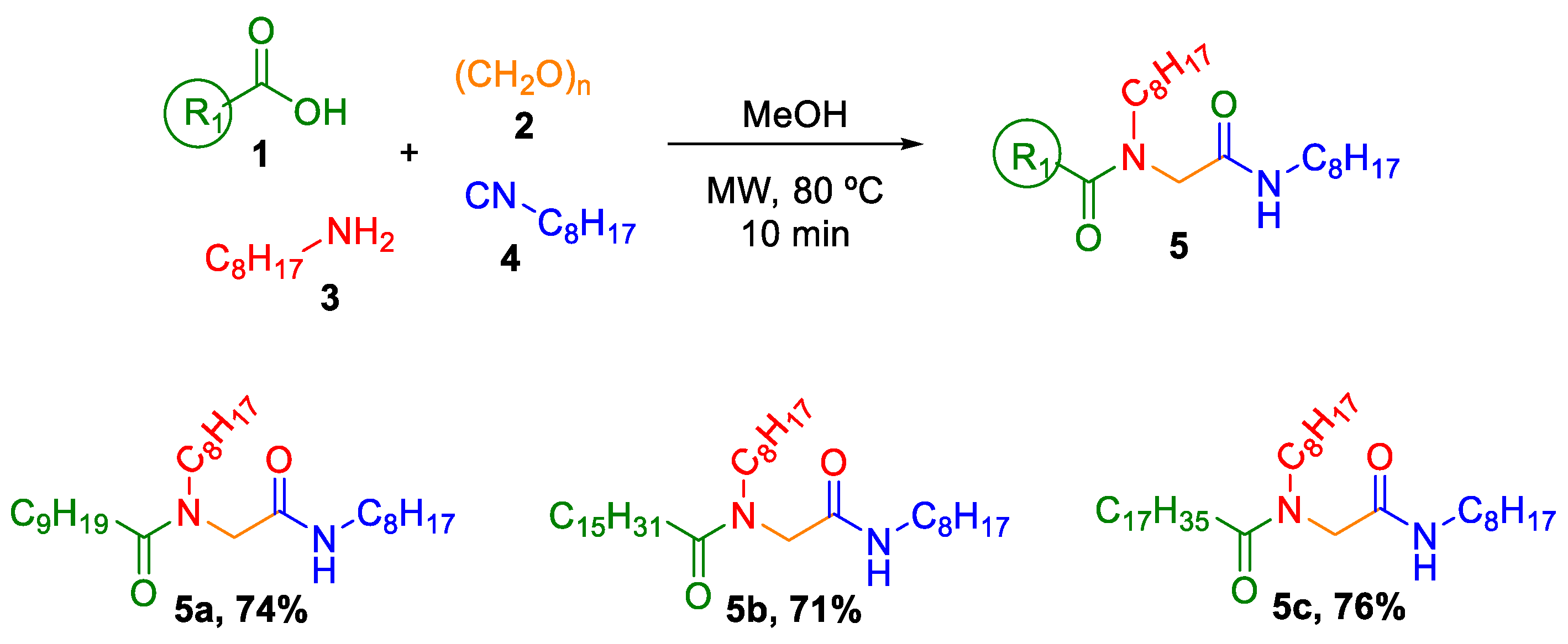
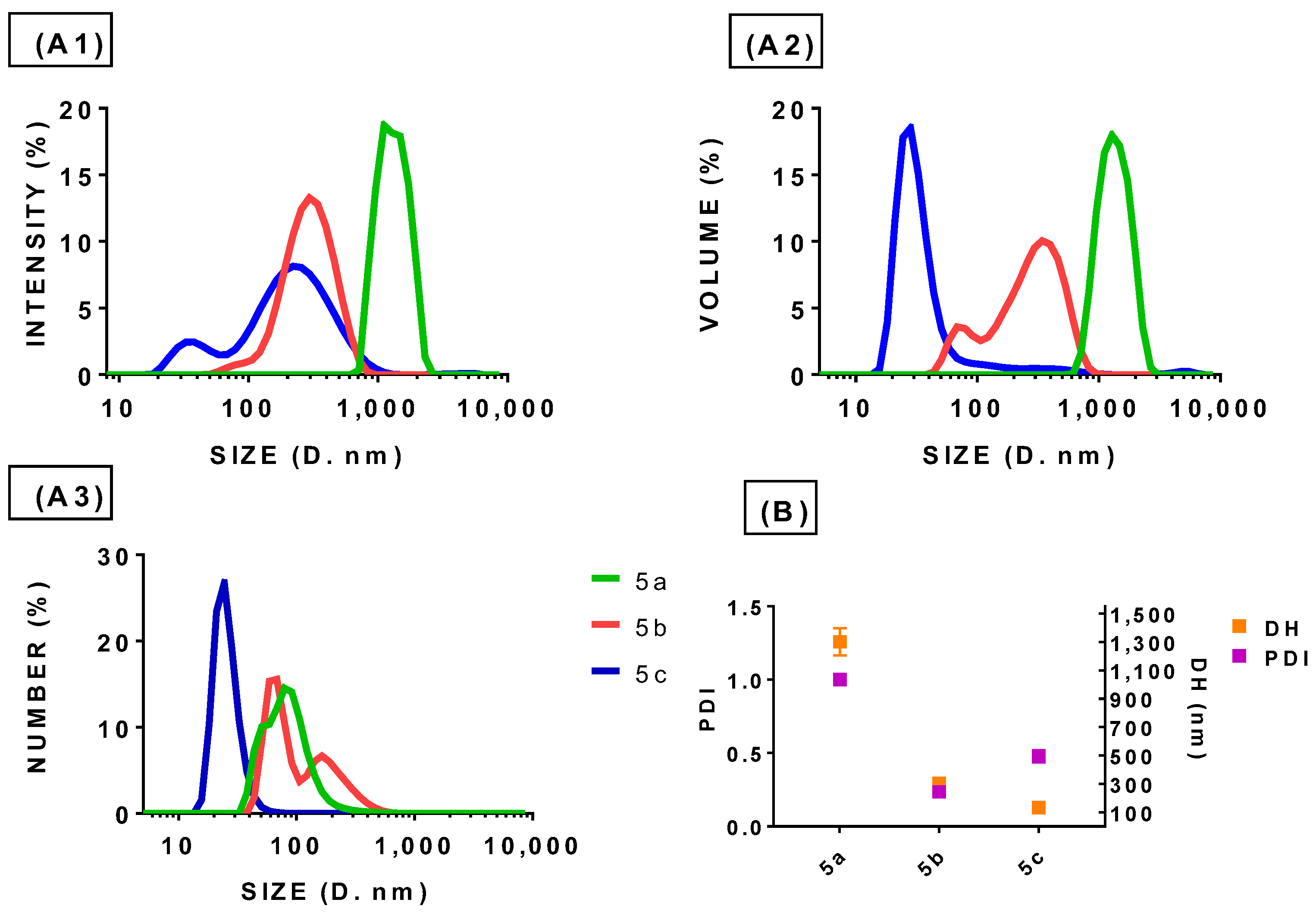
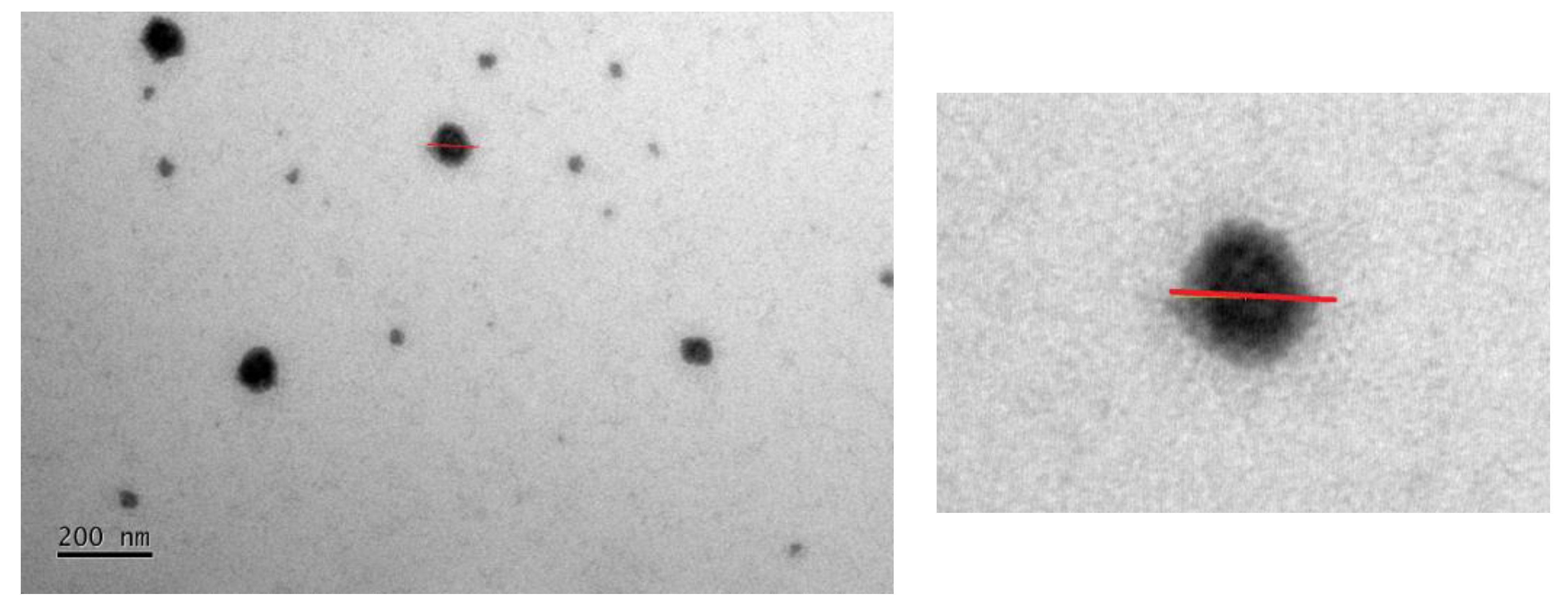


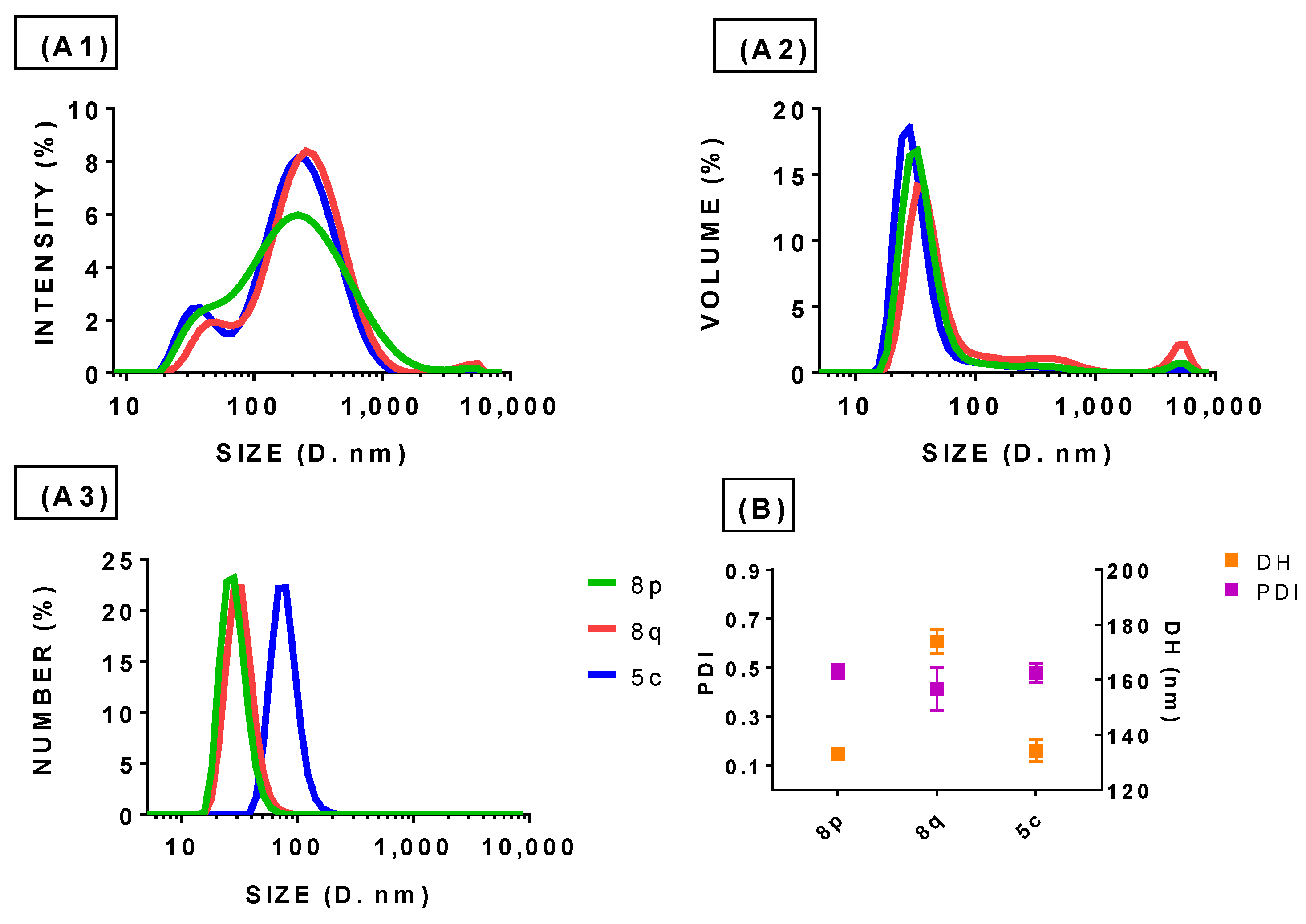
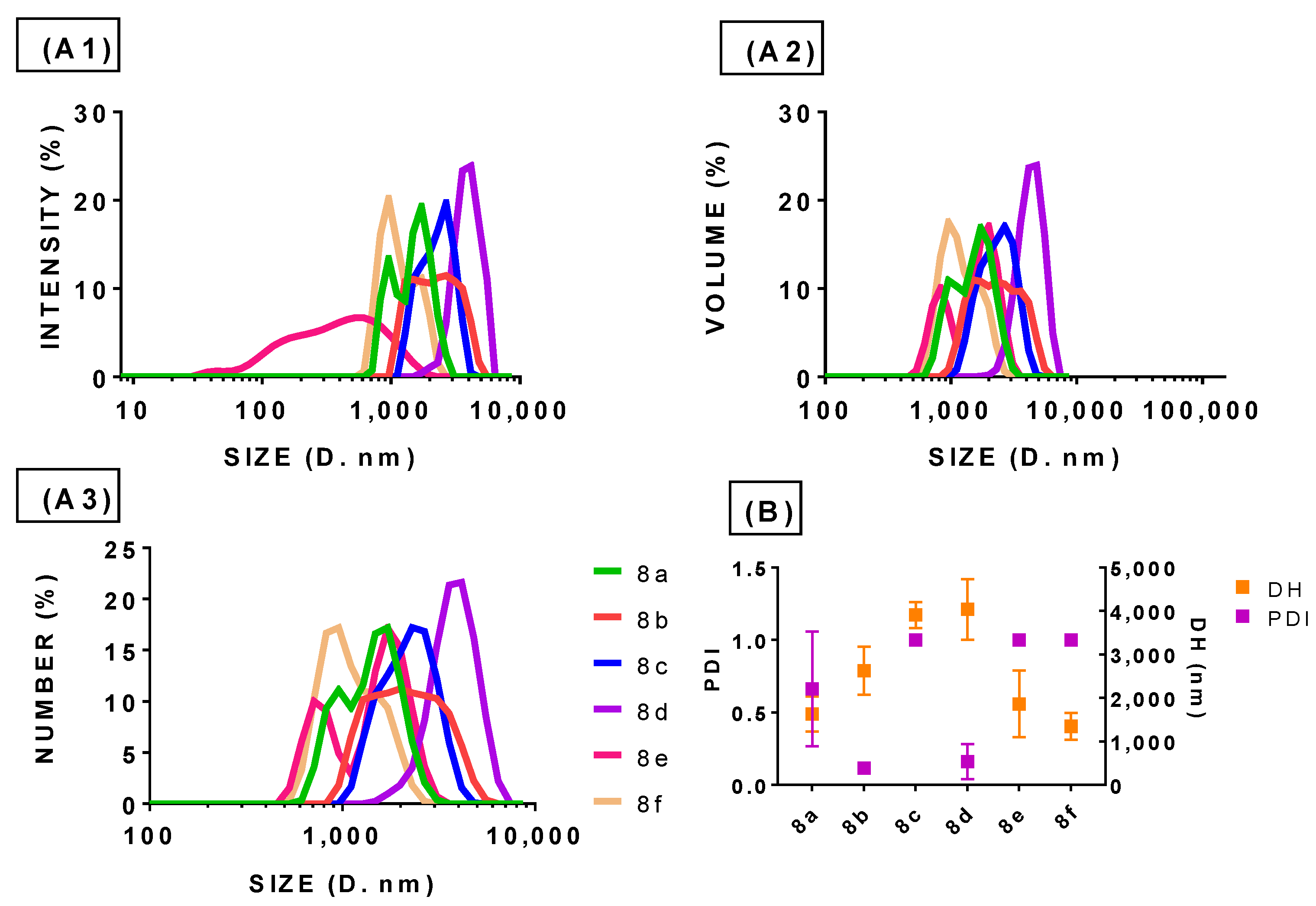
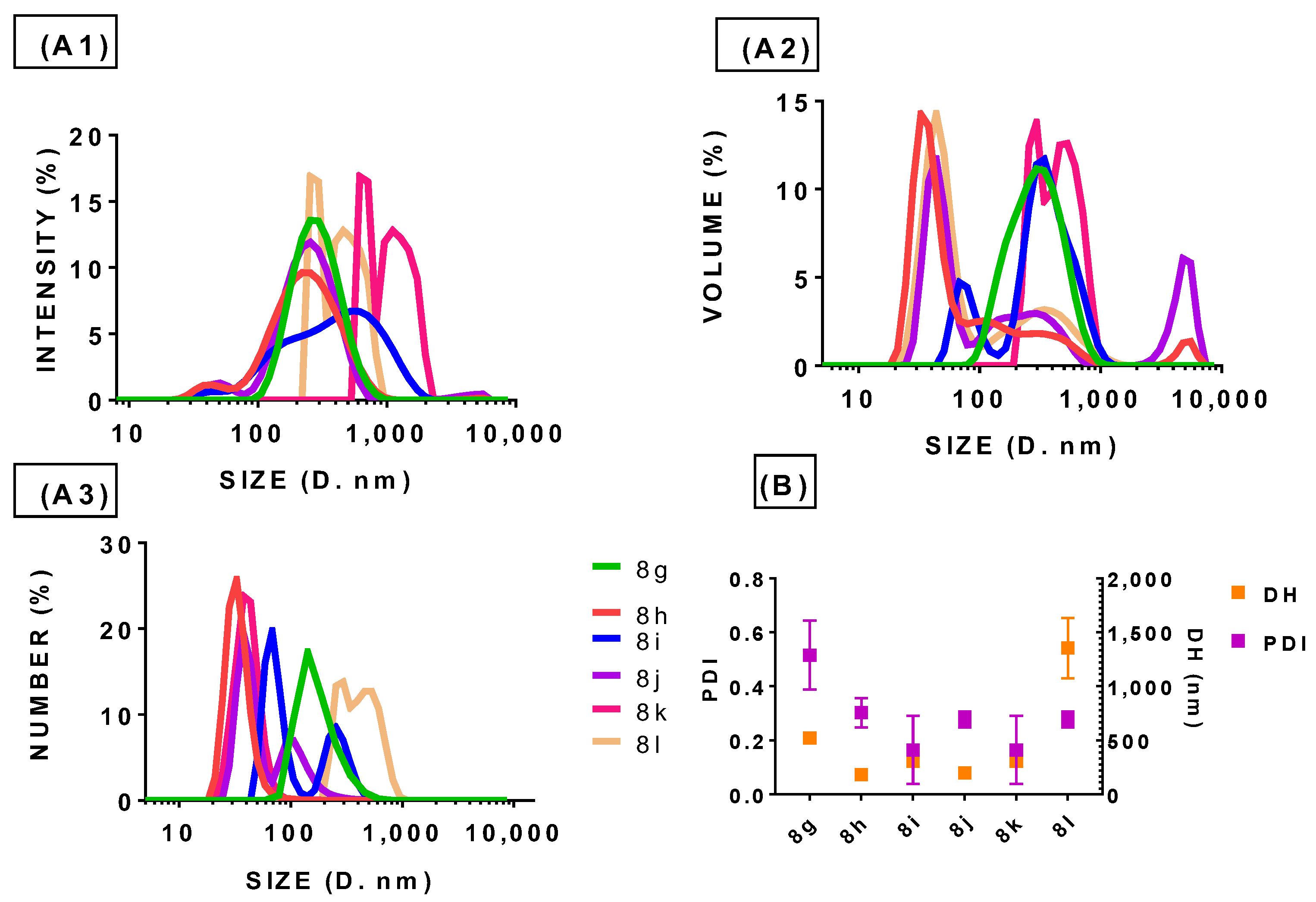
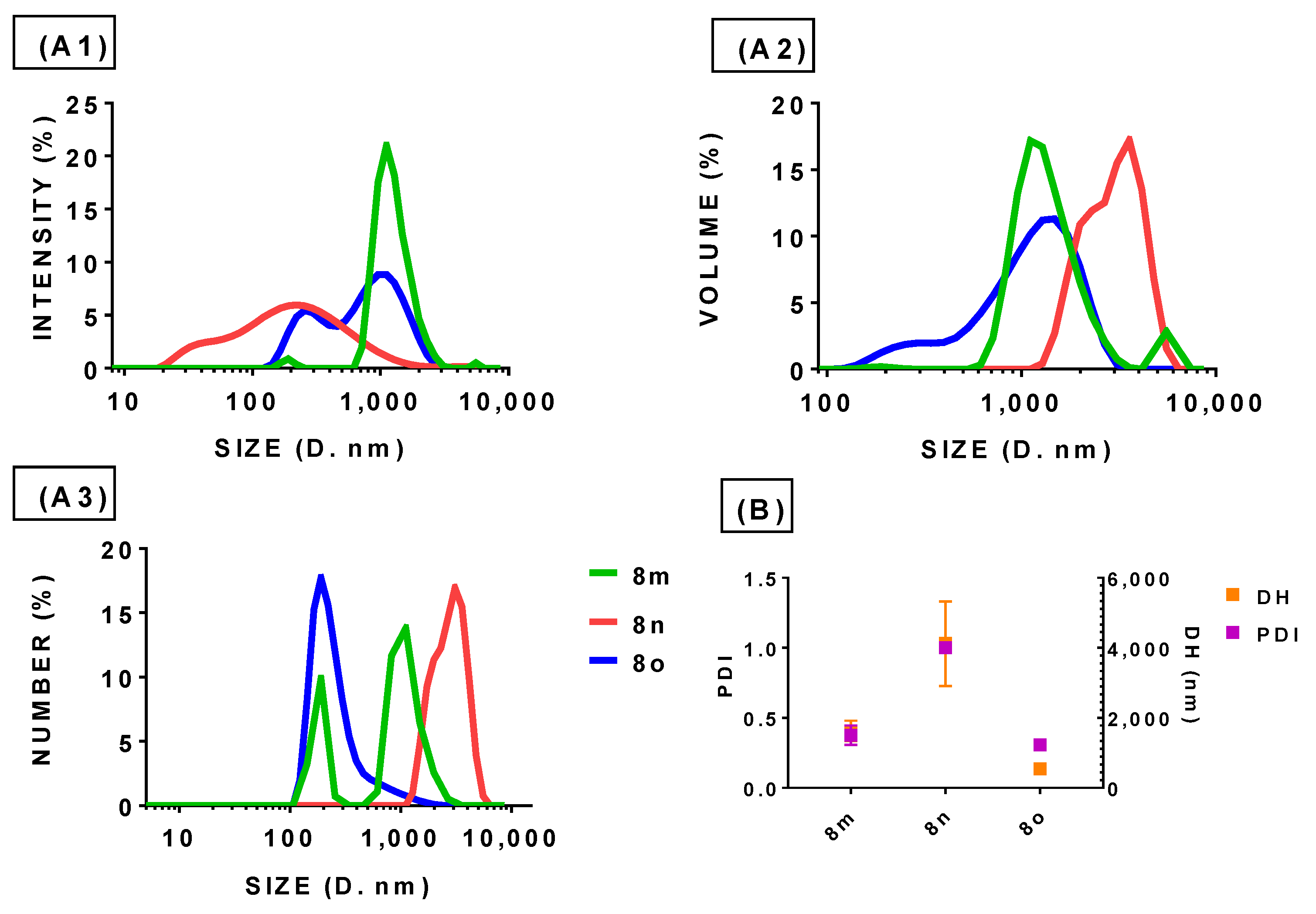
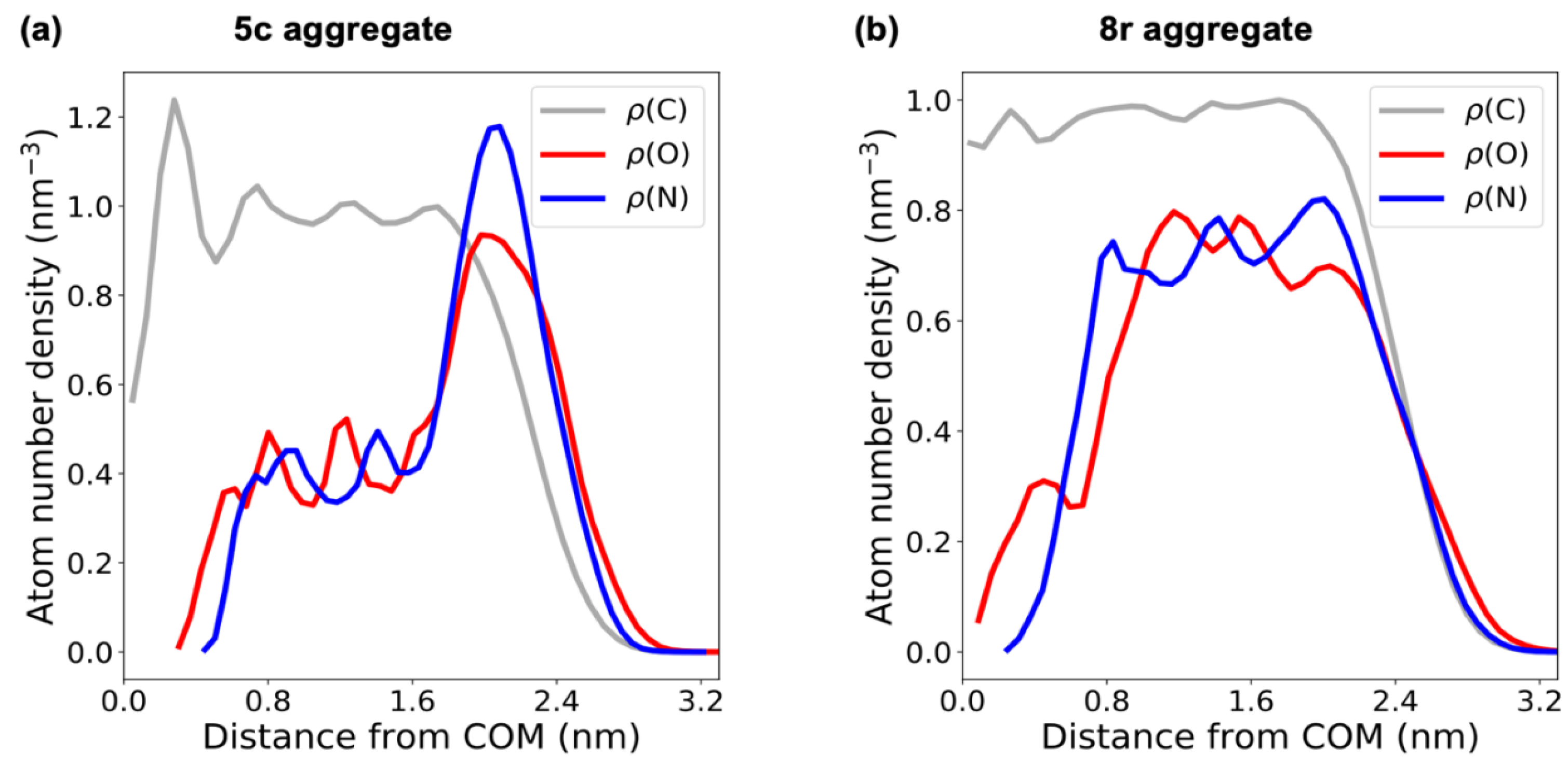
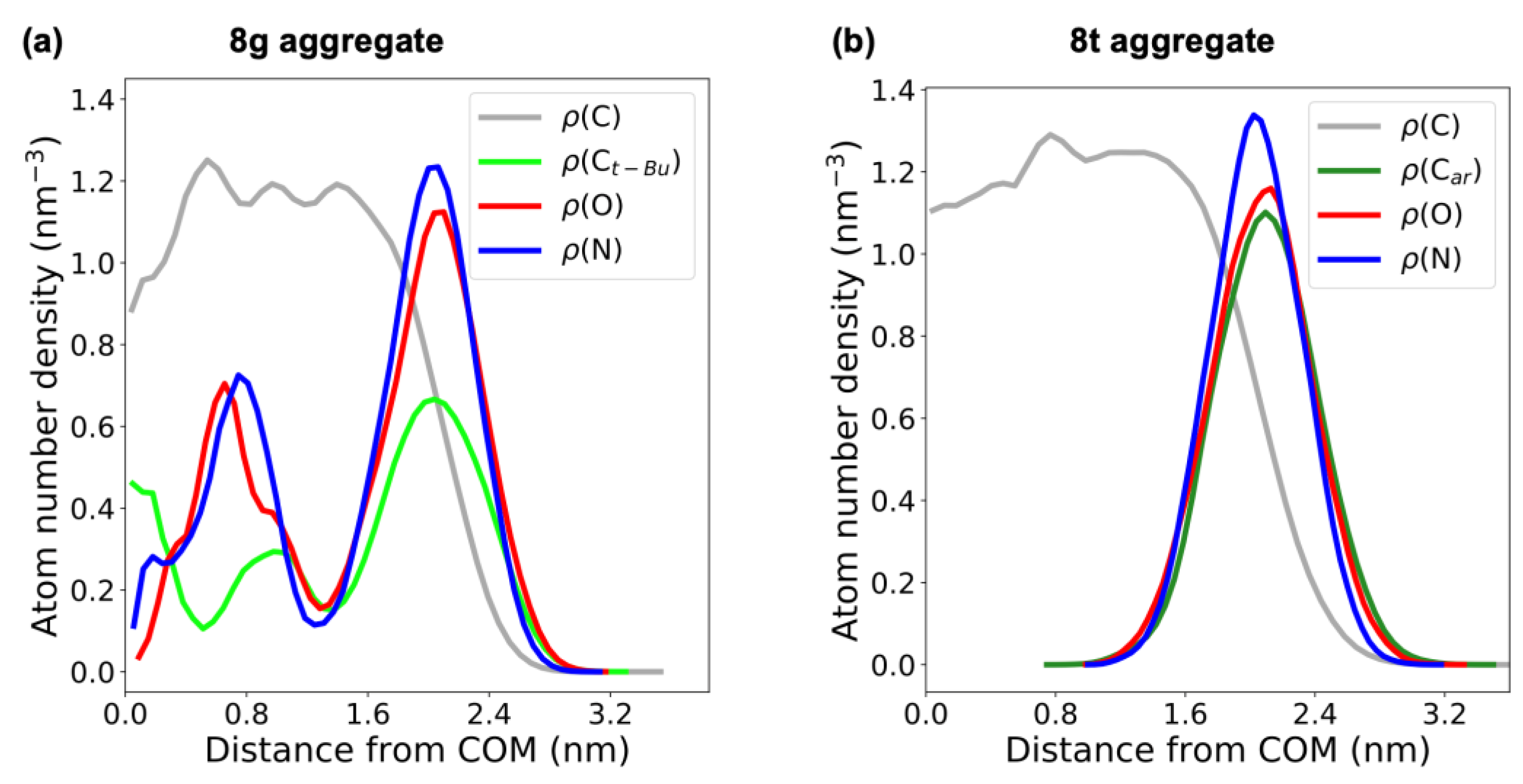


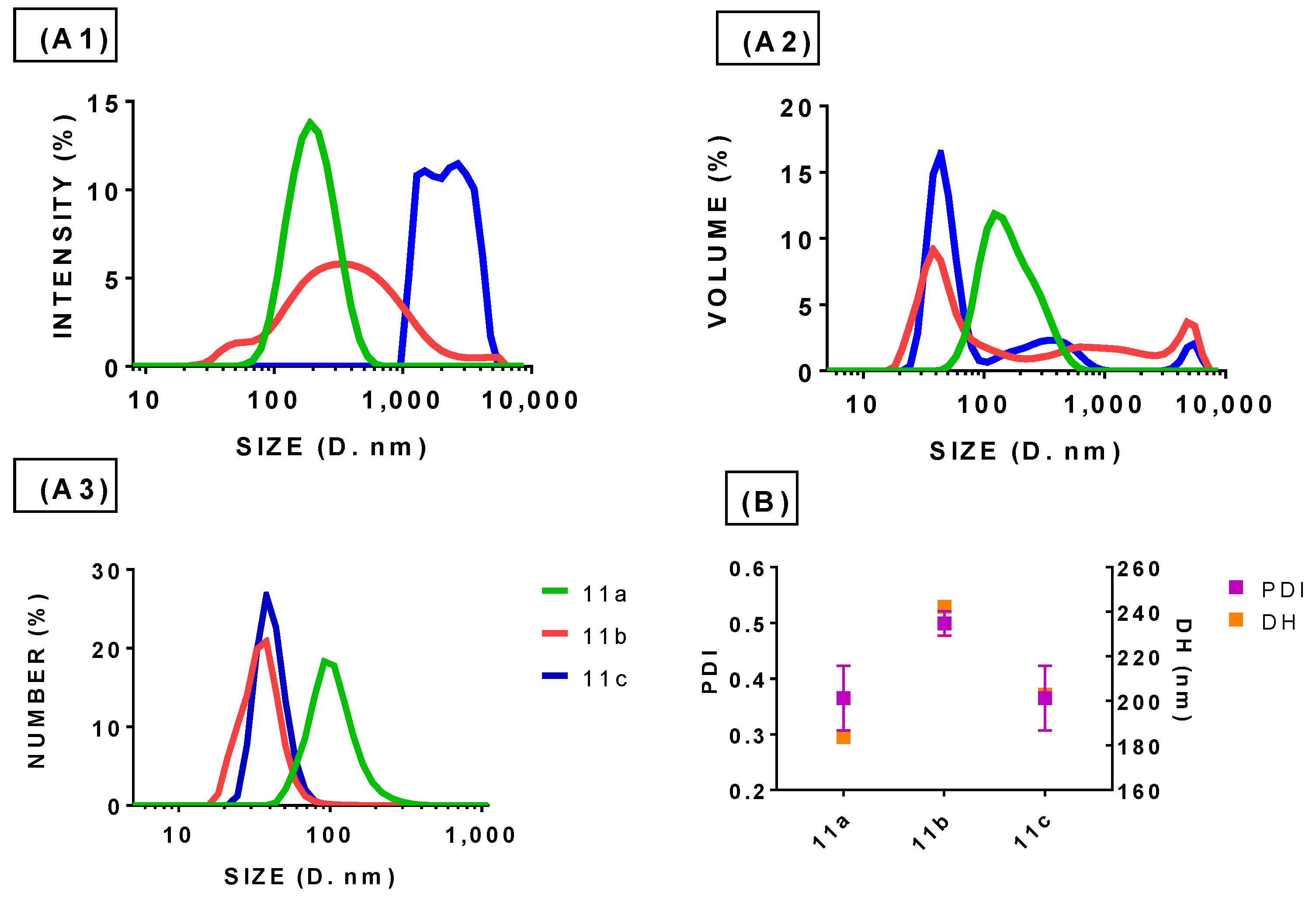
| Entry | Peptoids | Average Particle Size (nm) | PDI | Yield (%) |
|---|---|---|---|---|
| 1 |  | 1300 | 1.000 | 74 |
| 2 |  | 250 | 0.300 | 71 |
| 3 |  | 130 | 0.470 | 76 |
| 4 |  | 2000 | 0.700 | 55 |
| 5 |  | 2500 | 0.170 | 88 |
| 6 |  | 3500 | 1.000 | 69 |
| 7 |  | 4100 | 0.180 | 51 |
| 8 |  | 2000 | 1.000 | 87 |
| 9 |  | 1200 | 1.000 | 63 |
| 10 |  | 250 | 0.200 | 94 |
| 11 |  | 200 | 0.300 | 89 |
| 12 |  | 250 | 0.150 | 95 |
| 13 |  | 200 | 0.300 | 55 |
| 14 |  | 220 | 0.150 | 73 |
| 15 |  | 250 | 0.380 | 75 |
| 16 |  | 1700 | 0.350 | 64 |
| 17 |  | 4000 | 1.000 | 52 |
| 18 |  | 500 | 0.350 | 64 |
| 19 |  | 130 | 0.480 | 59 |
| 20 |  | 170 | 0.420 | 82 |
| 21 |  | 260 | 0.400 | 75 |
| 22 |  | 600 | 0.270 | 87 |
| 23 |  | 120 | 0.450 | 85 |
| 24 |  | 160 | 0.200 | 65 |
| 25 |  | 120 | 0.390 | 88 |
| 26 | 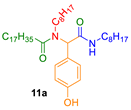 | 180 | 0.380 | 47 |
| 27 |  | 240 | 0.520 | 58 |
| 28 |  | 200 | 0.380 | 40 |
Disclaimer/Publisher’s Note: The statements, opinions and data contained in all publications are solely those of the individual author(s) and contributor(s) and not of MDPI and/or the editor(s). MDPI and/or the editor(s) disclaim responsibility for any injury to people or property resulting from any ideas, methods, instructions or products referred to in the content. |
© 2023 by the authors. Licensee MDPI, Basel, Switzerland. This article is an open access article distributed under the terms and conditions of the Creative Commons Attribution (CC BY) license (https://creativecommons.org/licenses/by/4.0/).
Share and Cite
Rosalba, T.P.F.; Matos, G.D.R.; Salvador, C.E.M.; Andrade, C.K.Z. Rational Design and Multicomponent Synthesis of Lipid–Peptoid Nanocomposites towards a Customized Drug Delivery System Assembly. Molecules 2023, 28, 5725. https://doi.org/10.3390/molecules28155725
Rosalba TPF, Matos GDR, Salvador CEM, Andrade CKZ. Rational Design and Multicomponent Synthesis of Lipid–Peptoid Nanocomposites towards a Customized Drug Delivery System Assembly. Molecules. 2023; 28(15):5725. https://doi.org/10.3390/molecules28155725
Chicago/Turabian StyleRosalba, Thaissa Pasquali F., Guilherme D. R. Matos, Carlos Eduardo M. Salvador, and Carlos Kleber Z. Andrade. 2023. "Rational Design and Multicomponent Synthesis of Lipid–Peptoid Nanocomposites towards a Customized Drug Delivery System Assembly" Molecules 28, no. 15: 5725. https://doi.org/10.3390/molecules28155725







